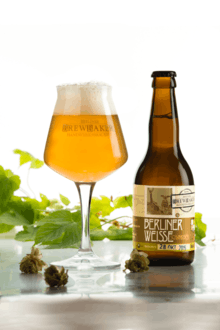Berliner Weisse

Berliner Weisse (German: Berliner Weiße) is a cloudy, sour, white beer of around 3% abv. It is a regional variation on the white beer style from Northern Germany, dating back to at least the 16th century. It can be made from combinations of barley and wheat malt, with the stipulation that the malts are kilned at very low temperatures to minimise colour formation. The fermentation takes place with a mixture of yeast and lactic acid bacteria, a prerequisite that creates the lactic acid taste, a distinguishing feature of Berlin Weissbier.[1]
By the late 19th century, Berliner Weisse was the most popular alcoholic drink in Berlin, with up to fifty breweries producing it. By the late 20th century, there were only two breweries left in Berlin producing the beer.[1] The style has been given Protected Geographical Indication within the EU, where it may only be applied to beers brewed in Berlin. There are a number of American and Canadian brewers who make a beer of similar style and give their product the Weisse label.[2]
History
Most beer authorities trace the origins of Berliner Weisse to an unknown beer being produced in Hamburg which was copied and developed by the 16th century brewer Cord Broihan.[3] Broihan's beer, Halberstädter Broihan, became very popular, and a version was being brewed in Berlin by the Berlin doctor J.S. Elsholz in the 1640s.[4] An alternative possibility, given by Protz among others, is that migrating Huguenots developed the beer from the local red and brown ales as they moved through Flanders into Northern Germany.[5] Some sources, such as Dornbusch, give the date 1572 as being the earliest record of the beer being brewed in Berlin.[6][7]
Frederick Wilhelm encouraged the spread of the beer through Prussia, declaring it as "best for our climate", and having his son, Frederick the Great, trained to brew it.[3] A popular story is that Napoleon's troops dubbed it "The Champagne of the North" in 1809.[6][8]
A typical modern strength for Berliner Weisse is around 3% abv, though strength may have varied at times. Traditionally, beers brewed in March (Märzen beers) were brewed stronger and allowed to mature over the summer months, and there is a report that this may have also happened with Berliner Weisse — the bottles being buried in sand or warm earth.[3][9]
Brewing

Modern brewing methods use a low proportion of wheat, generally ranging from 25% to 50%, and deliberately create a sourness either by a secondary fermentation in the bottle (Jackson suggests that traditionally bottles were buried in warm earth for several months), or by adding Lactobacillus.[3] Records from the early 19th century indicate that the beer was brewed from five parts wheat to one part barley, and drunk young, with little indication of creating sourness with either a secondary fermentation or by adding Lactobacillus.[10]
Brands
At the height of Berliner Weisse production in the 19th century, it was the most popular alcoholic drink in Berlin, and 700 breweries produced it.[11] By the end of the 20th century there were only two breweries left in Berlin, and a handful in the rest of Germany.[5] The two Berlin breweries, Berliner Kindl[12] and Schultheiss,[13] are both now owned by the Oetker Group and one of only two brands still produced in Berlin is Berliner Kindl Weisse. Exile Brewing Company in Des Moines, Iowa introduced a year-round Berliner Weisse named "Beatnik Sour" in 2014.[14] Saint Arnold Brewing Company in Houston, Texas is now making a Berliner Weisse called "Boiler Room".[15] Firestone Walker Barrelworks in Buellton, CA offers "Bretta Weisse", which undergoes secondary fermentation in French oak foeders for approximately 8 months.[16] The Bruery in Placentia, California also manufactures a Berliner Weisse-style beer called "Hottenroth".[17] Creature Comforts Brewing Co. in Athens, Georgia brews a Berliner Weisse beer called "Athena."[18]
Serving
Berliner Weisse is typically served in a bowl-shaped glass[19] with flavoured syrups,[20] such as raspberry (Himbeersirup), or artificial woodruff flavouring (Waldmeistersirup).[20] The beer may also be mixed with other drinks, such as pale lager, in order to balance the sourness.[20]
References
- 1 2 Annemüller, Gerolf. Die Berliner Weisse: ein Stück Berliner Geschichte. VLB Berlin, 2008.
- ↑ http://www.craftedpours.com/berliner-weisse
- 1 2 3 4 The world guide to beer, Michael Jackson, Mitchell Beazley, 1977, page 56 - "Berliner Weisse", ISBN 0-85533-126-7
- ↑ "Berliner weisse". www.brauer-bund.de. Retrieved 2009-08-07.
- 1 2 'Classic Bottled beers of the World, Roger Protz, Prion Books, 1997, "Berlin Wheat beer" - pages 81 and 82, ISBN 1-85375-219-3
- 1 2 The dictionary of beer and brewing - Google Books. books.google.co.uk. Retrieved 2009-08-07.
- ↑ Prost! The Story of German Beer, Horst D. Dornbusch, Brewers publications, 1997, "Berliner Wheat, a Spritzy, Sour Summer Refresher" - pages 112 - 113, ISBN 0-937381-55-1
- ↑ "Michael Jackson's Beer Hunter - Why the Germans should win ...". www.beerhunter.com. Retrieved 2009-08-07.
- ↑ "Die Herstellung obergähriger Biere", by Franz Schönfeld, 1902, page 88.
- ↑ The art of brewing - Google Books. books.google.co.uk. Retrieved 2009-08-07.
- ↑ "Berliner_Weisse". www.germanbeerinstitute.com. Retrieved 2009-08-07.
- ↑ "Berliner Kindl Brauerei (Oetker Group)". www.berliner-kindl.de. Retrieved 2009-10-29.
- ↑ "Schultheiss (Oetker Group)". schultheiss.de. Retrieved 2009-10-29.
- ↑ "Once, All Beer Was Made This Way: The Rebirth of Sour Beers". www.huffingtonpost.com. Retrieved 2015-08-07.
- ↑ "Berlin Breweries". www.europeanbeerguide.net. Retrieved 2009-08-07.
- ↑ "Bretta Weisse by Barrelworks". www.firestonebeer.com. Retrieved 2014-07-04.
- ↑ http://www.thebruery.com/beers/hottenroth.html
- ↑ http://www.creaturecomfortsbeer.com/beers/2014/5/7/athena
- ↑ The rough guide to Germany - Google Books. books.google.co.uk. Retrieved 2009-08-07.
- 1 2 3 The World Guide to Beer, Michael Jackson, Mitchell Beazley, ISBN 0-85533-126-7
Bibliography
- The World Guide to Beer, Michael Jackson, Mitchell Beazley, 1977, page 56 - "Berlner Weisse", ISBN 0-85533-126-7
- Die Biere Deutschlands, 1988, by Dietrich Höllhuber and Wolfgang Kaul, page 340, ISBN 3-418-00329-X
External links
| Wikimedia Commons has media related to German beers. |
- Berliner Weisse germanbeerinstitute.com